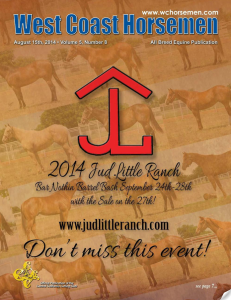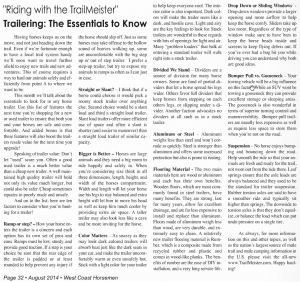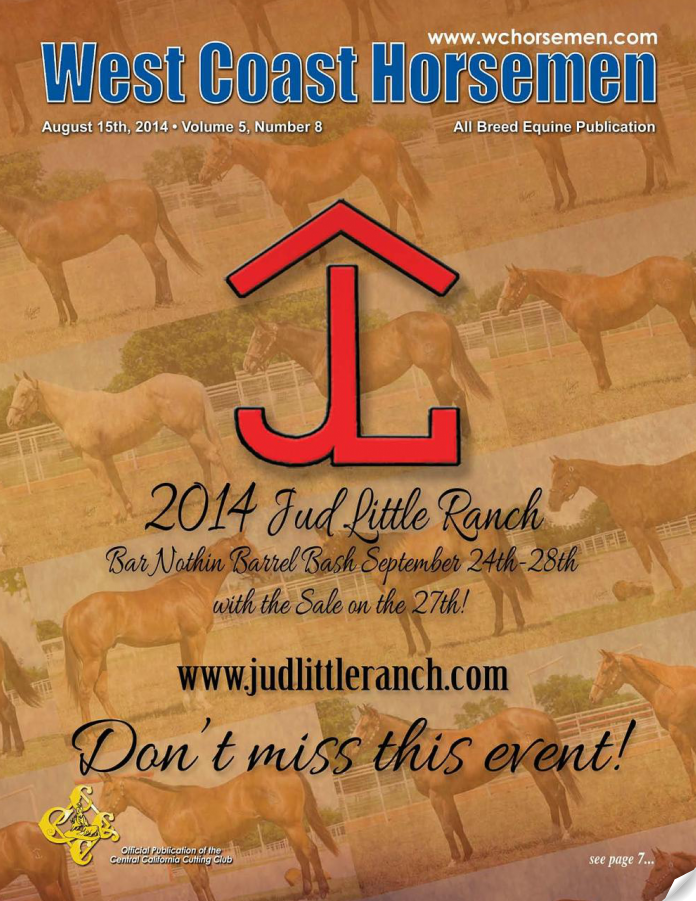 Trailering: The Essentials to Know – As Published in the August edition of West Coast Horsemen
Trailering: The Essentials to Know – As Published in the August edition of West Coast Horsemen
Having horses keeps us on the move, and not just heading down the trail. Even if we’re fortunate enough to have a local trail system handy we’ll soon want to travel further afield to enjoy new trails and new adventures. This of course requires a way to haul our animals safely and efficiently from point A to where we want to be.
This month we’ll talk about the essentials to look for in any horse trailer. Use this list of features the next time you’re shopping for a new or used trailer to ensure that both you and your horses are safe and comfortable. And added bonus is that these features will also boost the trailers resale value for the next time you upgrade!
Speaking of trailer value: Don’t let “used” scare you. Often a good used trailer is a much better value than a cheap new trailer. A well maintained high quality trailer will hold not only its value much longer, but could also be safer. Cheap sometimes equates to poorly made and unsafe.
And on to the list; here are ten factors to consider when you’re hunting for a trailer!
Ramp or Step? – How your horse enters the trailer is a concern and each option has its own set of pros and cons. Ramps must be low, sturdy, and provide good traction. If a step is your choice be sure that the rear edge of the trailer is padded or at least rounded to help prevent any injury if the horse should slip off. Just as some horses may take offense to the hollow sound of hooves walking up, some are uncomfortable with the big step up or out of step trailer. I prefer a step-up trailer, but try to expose my animals to ramps as often as I can just in case.
Straight or Slant? – I think that if a horse could choose it would pick a roomy stock trailer over anything else. Second choice would be a slant load and third a straight load trailer. Slant load trailers offer more efficient use of space and often a slant is shorter (and easier to maneuver) than a straight load trailer of similar capacity.
Bigger is Better – Horses are large animals and they need a big room to ride happily and safely in. When you’re considering size think in all three dimensions, length, height, and width of the horses compartment. Width and length will let your horse use his legs to stay balanced and extra height will let him to move his head as well as keep him much cooler by providing extra air space. A taller trailer may also look less like a cave and be more inviting for the horse.
Color Matters – As snazzy as they may look dark colored trailers will absorb heat just like the dark seats in your car, and make the trailer uncomfortably warm or even unsafely hot. Stick with a light color for your trailer to help keep everyone cool. The interior color is also important. Dark colors will make the trailer seem like a dark, and hostile cave. Light and airy are the key feelings to look for. Stock trailers are wonderful in these regards with lots of openings for light and air. Many “problem loaders” that balk at entering a standard trailer will walk right into a stock trailer.
Divided We Stand – Dividers are a source of division for many horse owners. Some are fond of partial dividers that let a horse spread his legs wider. Others favor full dividers that keep horses from stepping on each others legs, or slipping under a divider. Another faction advocates no dividers at all such as in a stock trailer.
Aluminum or Steel – Aluminum weighs less than steel and won’t corrode as quickly. Steel is stronger than aluminum and offers some increased protection but also is prone to rusting.
Flooring Material – The two main materials here are wood or aluminum and each has their own benefits. Wooden floors, which are most commonly found in steel trailers, have many benefits. They are strong, last for many years, allow for excellent drainage, and are far less expensive to install and replace than aluminum. Floors made of aluminum weigh less than wood, are very durable, and extremely easy to clean. A relatively new trailer flooring material is Rumber, which is a composite made from recycled rubber and plastic and comes in wood-like planks. The benefits of rumber are the ease of DIY installation, and a very long service life.
Drop Down or Sliding Windows – Drop down windows provide a larger opening and more airflow to help keep the horse comfy. Sliders take up less room. Regardless of the type of window make sure to have bars to keep the horse heads inside and screens to keep flying debris out. If you’ve ever had a bug hit you while driving you can understand why both are good ideas.
Bumper Pull vs. Gooseneck – Your towing vehicle will be a big influence on this factor. While an SUV wont be towing a gooseneck they can provide excellent storage or sleeping areas. The gooseneck is also wonderful in terms of superior turning control and maneuverability. Bumper pull trailers are usually less expensive as well as require less space to store them when you’re not on the road.
Suspension – No horse enjoys bumping and bouncing down the road. Help smooth the ride so that your animals are fresh and ready for the trail, not worn out from the ride there. Leaf springs ensure that the axle loads are always balanced and they used to be the standard for trailer suspension. Rubber torsion axles are said to have a smoother ride and typically sit higher than springs. The downside to torsion axles is that they don’t equalize, or balance the load which can put undo pressure on a single tire.
As always, for more information on this and other topics, as well as the nation’s largest source of mule trail and mule camping information in the U.S. please visit the all-new www.TrailMeister.com. Happy hauling!


